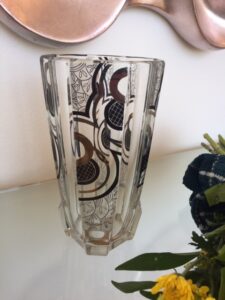 DF sent me a design by Rene Lalique from his later years. The fourteen-inch glass relief vase with silver and black overlay Art Deco designs gives me a perfect opportunity to write about the HOW and WHERE of Art Deco. From the 19th century to fairly recently, the world saw the “new” at World’s Fairs or Expositions. We take their existence for granted today, as in our youth we may have attended such a Fair. Before 1855 nothing like a World’s Fair convened, but something similar to DF’s vase originally appeared at a French Exposition.
DF sent me a design by Rene Lalique from his later years. The fourteen-inch glass relief vase with silver and black overlay Art Deco designs gives me a perfect opportunity to write about the HOW and WHERE of Art Deco. From the 19th century to fairly recently, the world saw the “new” at World’s Fairs or Expositions. We take their existence for granted today, as in our youth we may have attended such a Fair. Before 1855 nothing like a World’s Fair convened, but something similar to DF’s vase originally appeared at a French Exposition.
Rene Lalique made his previous glass designs in the Art Nouveau style. Lalique defined the early years of the Art Deco movement, as his style evolved from Art Nouveau or “New Art.” By the 1920s Art Deco became the “new” style. Unlike Art Nouveau, Art Deco was geometric, functional, with organic motifs, in luxury materials, such as the black and silver enameling on DF’s vase.
Other Takes on “New Art”
Although Lalique is famous for Art Nouveau and Art Deco designs in the French taste. Other nationalities presented their own take on “New Art,” notably Belgium, which produced amazing furniture by Victor Horta. The New Art style called Jugendstil, in designs by Bruno Mohring, as well as the predecessor to the Bauhaus, Vienna Secessionist designs of Otto Wagner.
Art Nouveau began in Belgium and France in the 1880’s as the first utterly unique style of design known for 300 years. The US market, although only the wealthy patrons, bought Tiffany glass in Art Nouveau designs. A short lived style, but loved, expensive then and still today on the auction market.
A theory in the history of design says that almost all new styles begin in metalwork, and Art Nouveau and Deco are no exceptions. Rene Lalique graduated from the Ecole Nationale Superieure des Arts Decoratifs de Paris and worked as a jewelry designer. The wealthy and famous, such as actress Sarah Bernhardt, purchased his work. In his later life he focused on glassmaking and became known for surfaces of dramatic relief (raised) designs. After 20 years of glassmaking, he built his own factory at Wingen-sur-Moder in Alsace in 1921.
Rene Lalique Goes to Exposition Universelle
But Art Nouveau and the seeds of Art Deco emerged at the 1900 Exposition Universelle in Paris. Lalique brought his Art Nouveau jewelry to the show from April 14 – November 12, 1900. This cemented his reputation.
The concept of the World’s Fair or Exposition began in 1851 in London at the Crystal Palace, a magnificent marvel of glass and steel greenhouse style engineering. The Exposition impressed Napoleon III with its variety and attendance, so he brought the idea to France to celebrate everything FRENCH. He oversaw the Paris Universal Exposition 1855, 1867, and another in 1878 to celebrate the historic defeat of the Paris Commune. Another in 1899 celebrated the centennial of the French Revolution. France became known for her Fairs, the height being the Exposition Internationale des Arts Decoratifs et Industriels Modernes in 1925.
The Fair attended by Lalique in 1900 offered some of the ‘firsts’ of technology to the world. A total of 50 million people may have seen one or more of the following:
- “Galalith”
- the first synthetic plastic
- Russian Nesting dolls
- Ferris Wheel
- moving sidewalk
- passenger trolleybus
- escalators
- diesel engines
- electric cars and fire engines
- dry cell batteries
- magnetic audio recorder
- talking films
People didn’t just view decorative art, but many marvels celebrating French design, putting France at the center of the design world.
Structures built for the Exposition which still stand today are the Grand Palais, Pont Alexandre III, the Gare d’Orsay Railroad station, and a few of Hector Guimard’s Paris Metro archways. Many of the structures built in the Beaux Arts Style for the Exposition were decorated with ironwork and relief features in the Art Nouveau style. To mention only one of the restaurants that featured Art Nouveau designs, I think of Maxim’s.
Blurring the Lines
If you own a piece of Lalique, a bowl, a vase, a perfume bottle, you can picture a piece, although more “Art Nouveau” in style than DF’s vase, on show at the Exposition of 1900. DF’s vase is pure geometric high style Art Deco, but the stylistic dividing line between Art Nouveau and Art Deco is blurred as one style moved in to the next. The value is $450.